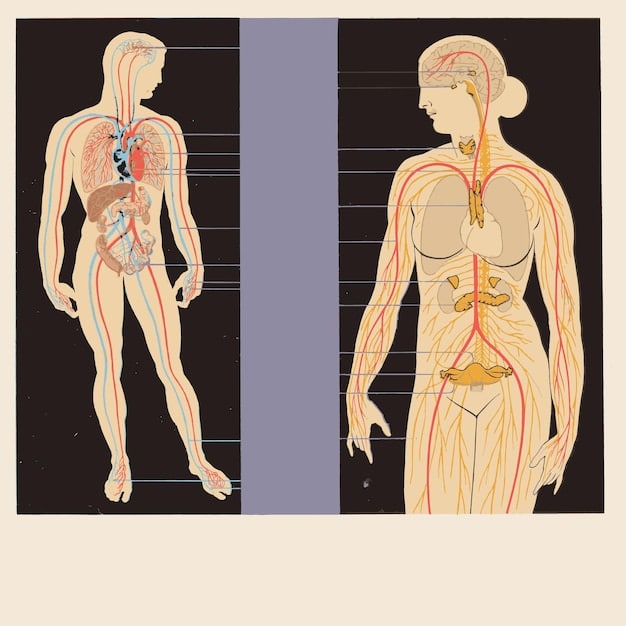Can Mindfulness Meditation Reduce Blood Pressure by 5 Points?

Mindfulness meditation offers a promising non-pharmacological approach to blood pressure management, with accumulating evidence suggesting its potential to contribute to modest but clinically significant reductions, even reaching the targeted 5-point decrease within a three-month period for some individuals due to its impact on stress and the autonomic nervous system.
In a world increasingly seeking holistic approaches to health, the question, “Can mindfulness meditation reduce your blood pressure by 5 points in 3 months?” resonates deeply. This inquiry explores the fascinating intersection of mind, body, and modern medicine, inviting us to consider whether ancient practices hold contemporary answers for a widespread health concern.
Understanding Blood Pressure and Its Impact
Blood pressure, often called the “silent killer,” is a fundamental health metric reflecting the force of blood against artery walls. When this force is consistently too high, it’s known as hypertension. This condition places immense strain on the cardiovascular system, making the heart work harder and potentially damaging blood vessels throughout the body.
Hypertension is a major risk factor for several severe health complications, including heart attacks, strokes, kidney disease, and even certain forms of dementia. Understanding its nuances is critical for effective management and prevention.
systolic and diastolic pressure
When measurements are taken, two numbers are always given: systolic and diastolic pressure. Systolic pressure, the top number, indicates the pressure when the heart beats and pumps blood. The bottom number, diastolic pressure, measures the pressure when the heart rests between beats.
- Optimal blood pressure is generally considered to be less than 120/80 mmHg.
- Elevated blood pressure refers to readings consistently between 120-129 systolic and less than 80 diastolic.
- Hypertension Stage 1 is diagnosed when readings are 130-139 systolic or 80-89 diastolic.
- Hypertension Stage 2 is 140/90 mmHg or higher.
These classifications are crucial for determining the appropriate course of action, whether it involves lifestyle modifications or pharmacological interventions.
The body’s intricate regulatory systems
The body’s intricate regulatory systems, primarily the autonomic nervous system, play a significant role in blood pressure regulation. Chronic stress activates the sympathetic nervous system, often dubbed the “fight or flight” response, leading to increased heart rate and vasoconstriction. Over time, this heightened state can contribute to persistent high blood pressure. Lifestyle factors also heavily influence blood pressure levels. Diet, physical activity, alcohol consumption, and smoking all contribute to an individual’s blood pressure profile, making comprehensive management a multi-faceted endeavor.
By understanding these foundational aspects of blood pressure, we can better appreciate how interventions like mindfulness meditation might exert their beneficial effects, not just on symptomatology but on the underlying physiological mechanisms.
Unpacking Mindfulness Meditation
Mindfulness meditation, at its core, is the practice of intentionally bringing one’s attention to the present moment without judgment. It involves observing thoughts, feelings, bodily sensations, and the surrounding environment with an attitude of acceptance and curiosity. Originating from ancient Buddhist traditions, mindfulness has been increasingly secularized and integrated into Western contexts as a tool for stress reduction and well-being.
Unlike other forms of meditation that might focus on specific visualizations or mantras, mindfulness emphasizes direct, non-analytical awareness. Regular practice is believed to cultivate a more balanced and equanimous approach to life’s challenges.
Core Principles of Mindfulness
The core principles of mindfulness include several key elements:
- Present Moment Awareness: Focusing solely on what is happening right now, rather than dwelling on the past or worrying about the future.
- Non-Judgment: Observing thoughts and feelings without labeling them as “good” or “bad,” simply acknowledging their presence.
- Acceptance: Acknowledging and allowing experiences to be as they are, without resistance.
- Openness and Curiosity: Approaching each moment with freshness and a willingness to explore.
These principles are not just theoretical; they form the foundation for practical techniques practiced during meditation.
Common Mindfulness Techniques
Common mindfulness techniques typically involve focused attention and body awareness. The breath is often used as an anchor, bringing the mind back to the present whenever it wanders. Body scan meditation guides practitioners to systematically bring awareness to different parts of the body, noticing sensations. Walking meditation extends this awareness to the physical act of walking, tuning into the sensations of movement.
While often practiced in a formal setting, mindfulness can also be integrated into daily life. This “informal mindfulness” involves bringing present moment awareness to routine activities like eating, drinking, or washing dishes. The cumulative effect of these practices is thought to improve emotional regulation, reduce reactivity to stress, and enhance overall cognitive flexibility. It’s this profound connection between mind and body that positions mindfulness as a potential ally in managing conditions like hypertension.
The Mind-Body Connection and Blood Pressure
The intricate relationship between our mental state and physical health is well-documented, especially concerning blood pressure. Stress, a pervasive element of modern life, triggers a cascade of physiological responses designed to prepare the body for immediate action. While beneficial in acute situations, chronic activation of this stress response can be detrimental to cardiovascular health.
Mindfulness meditation directly addresses this connection by cultivating a different kind of response to stress—one of calm awareness rather than reactive alarm. This shift has profound implications for blood pressure regulation.
Physiological Pathways
At the heart of the mind-body connection lie the physiological pathways linking stress and blood pressure. When faced with a perceived threat, the sympathetic nervous system kicks into gear, releasing stress hormones like adrenaline and cortisol. These hormones increase heart rate, constrict blood vessels, and raise blood sugar levels, all contributing to elevated blood pressure.
Conversely, the parasympathetic nervous system, responsible for the “rest and digest” functions, helps lower heart rate and relax blood vessels, thereby reducing blood pressure. Mindfulness practice is thought to enhance the activity of the parasympathetic nervous system, promoting a state of relaxation and balance. Over time, regular activation of this calming response can lead to a more stable and lower baseline blood pressure.
Stress Reduction and Autonomic Regulation
The primary mechanism through which mindfulness may impact blood pressure is stress reduction. By training the mind to observe thoughts and feelings without judgment, individuals can learn to respond to stressors with greater equanimity, rather than immediate physiological arousal. This includes a more refined regulation of the autonomic nervous system.

Improved autonomic regulation effectively means the body becomes less reactive to stress and more adept at returning to a state of calm. This not only reduces the immediate spikes in blood pressure caused by stress but may also contribute to a sustained decrease in overall blood pressure levels. The ability to consciously influence these involuntary bodily functions through mindfulness points to its significant therapeutic potential.
Ultimately, the mind-body connection illustrates how internal states, particularly those related to stress and emotion, are not merely abstract experiences but have tangible, measurable effects on our physical health, making mindfulness a powerful tool for wellness.
Evidence for Mindfulness and Blood Pressure Reduction
The scientific community has increasingly turned its attention to the potential of mindfulness meditation as an adjunctive therapy for various health conditions, including hypertension. A growing body of research, from small pilot studies to larger meta-analyses, provides valuable insights into whether and by how much mindfulness can influence blood pressure.
While the goal of a 5-point reduction in three months is specific, the general trend in the literature suggests a positive, albeit modest, effect.
Key Studies and Findings
Several influential studies have explored the impact of mindfulness on blood pressure. A meta-analysis published in JAMA Internal Medicine in 2014, for instance, reviewed numerous studies on Transcendental Meditation (a specific form of meditation) and found a statistically significant reduction in blood pressure. While not strictly mindfulness, this highlights the general principle that meditation can affect cardiovascular markers.
More specifically concerning mindfulness, a review published in the Journal of the American Heart Association in 2017 concluded that meditation programs, including mindfulness-based stress reduction (MBSR), could lead to modest reductions in blood pressure. Another study in the journal Psychosomatic Medicine in 2019 suggested that an 8-week MBSR program led to significant reductions in both systolic and diastolic blood pressure among individuals with prehypertension and Stage 1 hypertension. These studies often report reductions ranging from 2-5 mmHg for systolic and 1-3 mmHg for diastolic pressure.
Mechanisms of Action Observed
Researchers posit several mechanisms by which mindfulness meditation achieves its observed effects on blood pressure. Beyond the direct stress reduction mentioned earlier, these include:
- Reduced Sympathetic Nervous System Activity: Less “fight or flight” activation means lower heart rate and blood vessel constriction.
- Enhanced Parasympathetic Nervous System Tone: Increased “rest and digest” activity promotes relaxation and vasodilation.
- Improved Endothelial Function: Regular mindfulness may enhance the health and flexibility of blood vessel linings.
- Better Lifestyle Choices: Mindfulness can foster greater self-awareness, leading to healthier eating habits, increased physical activity, and reduced alcohol/tobacco use.
While a 5-point drop in three months is an ambitious but achievable target for some, it’s important to note that individual responses vary, and meditation works best as part of a holistic health strategy. The evidence, however, strongly supports mindfulness as a credible intervention for blood pressure management.
Setting Realistic Expectations: 5 Points in 3 Months?
The idea of reducing blood pressure by a specific amount within a set timeframe, such as 5 points in 3 months, is appealing because it offers a clear and measurable goal. While mindfulness meditation holds promise, it’s crucial to approach this with realistic expectations. The efficacy can vary significantly from person to person, and several factors influence the outcome.
Individual Variability
Firstly, individual variability plays a substantial role. The baseline blood pressure, the presence of underlying health conditions, and the individual’s overall lifestyle all contribute to how responsive their blood pressure will be to mindfulness intervention. For someone with very high blood pressure, a 5-point reduction might be a good start, but perhaps not the ultimate goal. For someone closer to the optimal range, a 5-point drop could be more challenging to achieve or might signify a clinically significant shift.
The consistency and depth of meditation practice are also key. Sporadic practice is unlikely to yield the same results as daily, dedicated meditation. Personal commitment and belief in the practice can also influence outcomes, as the placebo effect, though often underestimated, can contribute to positive health changes.
Factors Influencing Outcomes
Several factors can influence the success of mindfulness in reducing blood pressure:
- Consistency of Practice: Daily meditation, even for short durations, is more effective than infrequent sessions.
- Duration of Practice: Longer meditation sessions or more accumulated practice hours tend to show greater effects.
- A Baseline Blood Pressure: Individuals with higher initial blood pressure might experience more noticeable drops.
- Lifestyle Integration: Mindfulness combined with a healthy diet, regular exercise, and adequate sleep often yields better results.
- Severity of Hypertension: Mindfulness might be more effective for prehypertension or mild hypertension, acting as an excellent preventive or early intervention tool. Severer cases might require complementary medical management.
While a 5-point reduction within three months is certainly within the realm of possibility for many individuals practicing mindfulness consistently, it should be viewed as part of a broader health journey. It’s a realistic and desirable goal, but not a guaranteed outcome for everyone. Progress should be monitored, and mindfulness should be integrated within a comprehensive health plan, ideally in consultation with healthcare professionals.
Integrating Mindfulness into Your Routine
For mindfulness meditation to have a meaningful impact on blood pressure and overall well-being, it needs to be consistently integrated into daily life. This goes beyond understanding the concept; it requires practical application. Starting small and gradually building up a routine is often the most sustainable approach.
Consistency is more important than duration in the early stages, as even a few minutes of daily practice can begin to train the mind and body. The goal is to make mindfulness a habit, seamlessly woven into the fabric of your day.
Practical Tips for Beginners
If you’re new to mindfulness, here are some practical tips to get started:
- Start Small: Begin with 5-10 minutes of meditation per day. A shorter, consistent practice is more beneficial than intermittent long sessions.
- Choose a Quiet Time and Place: Find a time when you won’t be disturbed and a comfortable, quiet space where you can sit or lie down.
- Use Guided Meditations: Many apps (e.g., Calm, Headspace) and online resources offer guided meditations that are excellent for beginners. They provide instructions and help keep you focused.
- Focus on Your Breath: The breath is a common anchor in mindfulness. Simply observe the sensation of your breath without trying to change it. Your mind will wander; gently bring it back to your breath.
Remember, there’s no “right” way to do mindfulness, and consistency is key. Don’t get discouraged if your mind wanders; that’s part of the process.

Consistency and Long-Term Benefits
The real benefits of mindfulness, including the potential for blood pressure reduction, accrue over time with consistent practice. While three months might show initial shifts, the long-term impact is more profound. Regular mindfulness can lead to sustained changes in how your body responds to stress, improving autonomic balance and fostering resilience.
Beyond blood pressure, consistent mindfulness contributes to better sleep, improved emotional regulation, reduced anxiety, and enhanced cognitive function. These holistic benefits create a positive feedback loop, further supporting cardiovascular health. Integrating mindfulness isn’t just about reducing a number; it’s about cultivating a healthier relationship with your mind and body for lasting well-being.
Limitations and Considerations
While the potential benefits of mindfulness meditation for blood pressure are compelling, it’s vital to acknowledge its limitations and integrate it within a comprehensive healthcare strategy. Mindfulness is a powerful complementary tool, but it is not a standalone cure, particularly for moderate to severe hypertension.
Patients should always consult with their healthcare providers before making significant changes to their hypertension management plan, especially regarding prescribed medications. Dismissing conventional medical advice for alternative therapies can have serious health consequences.
Mindfulness as a Complementary Therapy
Mindfulness meditation should primarily be viewed as a complementary therapy. This means it works best when used in conjunction with, rather than instead of, established medical treatments. For individuals with diagnosed hypertension, this often includes lifestyle modifications such as dietary changes (e.g., DASH diet), regular physical activity, weight management, and, crucially, prescribed medications.
Mindfulness can enhance the effectiveness of these conventional approaches by reducing stress, improving adherence to healthier habits, and fostering overall well-being. It helps manage the psychological load often associated with chronic health conditions, enabling patients to feel more in control and resilient.
Consulting Healthcare Professionals
The importance of consulting healthcare professionals cannot be overstated. A doctor can accurately diagnose hypertension, determine its severity, and recommend an appropriate treatment plan tailored to individual needs. This plan might involve medication to achieve immediate and significant blood pressure reductions, which mindfulness alone may not achieve.
Regular monitoring of blood pressure under medical guidance is essential to track progress and adjust treatments as needed. Healthcare providers can also help assess whether mindfulness is a suitable addition to a patient’s regimen, considering any co-existing conditions or personal circumstances. They can ensure that the integration of mindfulness is safe and contributes positively to overall health outcomes, rather than delaying necessary medical intervention.
In conclusion, while mindfulness offers a promising avenue for blood pressure management and stress reduction, it’s crucial to maintain a balanced perspective, recognizing its role as a supportive element within a broader, medically supervised health strategy.
| Key Point | Brief Description |
|---|---|
| 🧘♀️ Mindfulness & BP | Mindfulness may reduce blood pressure by calming the nervous system and reducing stress responses. |
| 📉 5-Point Target | A 5-point reduction in 3 months is a realistic, albeit individually varied, goal for consistent practitioners. |
| ⏱️ Consistency Matters | Regular daily practice is key to achieving and sustaining blood pressure benefits. |
| 👩⚕️ Consult Doctor | Mindfulness is a complementary therapy; always consult a healthcare professional. |
Frequently Asked Questions About Mindfulness and Blood Pressure
▼
Mindfulness meditation works primarily by reducing chronic stress, which is a major contributor to high blood pressure. It activates the parasympathetic nervous system, promoting a “rest and digest” state. This counteracts the “fight or flight” response, leading to a decrease in heart rate and dilation of blood vessels, which can lower both systolic and diastolic blood pressure over time.
▼
Yes, studies have shown that 8-week Mindfulness-Based Stress Reduction (MBSR) programs can be effective in reducing blood pressure, particularly in individuals with prehypertension or mild hypertension. Participants often experience modest but clinically significant drops in their readings, supporting MBSR as a valuable non-pharmacological intervention for blood pressure management.
▼
No, you should never stop or adjust your blood pressure medication without consulting your doctor. Mindfulness is a complementary therapy, meaning it supports conventional medical treatment. Your healthcare provider can assess your progress, monitor your blood pressure, and determine if any medication adjustments are safe and appropriate based on your overall health status.
▼
Even short, consistent periods of meditation can yield benefits. Many studies on blood pressure reduction use daily sessions of 15-30 minutes. However, beginners can start with 5-10 minutes a day and gradually increase the duration. The key is consistency; regular daily practice is more impactful than sporadic long sessions for achieving sustained health improvements.
▼
For optimal blood pressure management, mindfulness should be integrated with other healthy lifestyle changes. These include adopting a balanced diet (like the DASH diet), engaging in regular physical activity, maintaining a healthy weight, limiting alcohol intake, and avoiding smoking. These combined strategies create a synergistic effect, enhancing overall cardiovascular health.
Conclusion
The journey to answer whether mindfulness meditation can reduce blood pressure by 5 points in 3 months reveals a resounding “yes” for many, albeit with crucial caveats. The scientific evidence strongly indicates that mindfulness fosters a state of physiological calm, directly impacting stress responses and autonomic nervous system regulation, which in turn can lead to clinically significant reductions in blood pressure. While individual results vary and consistency is paramount, the potential for a 5-point shift within a quarter is a realistic and achievable goal for consistent practitioners, especially when integrated into a holistic health approach. However, mindfulness remains a powerful complementary therapy, best utilized in conjunction with professional medical advice and other proven lifestyle modifications, ensuring a safe and comprehensive path toward optimal cardiovascular well-being.





